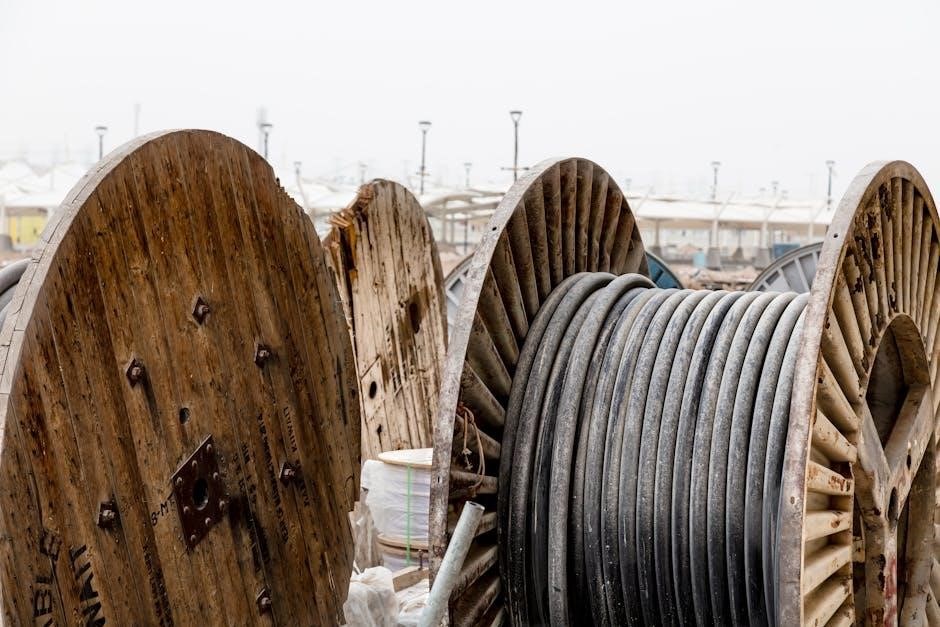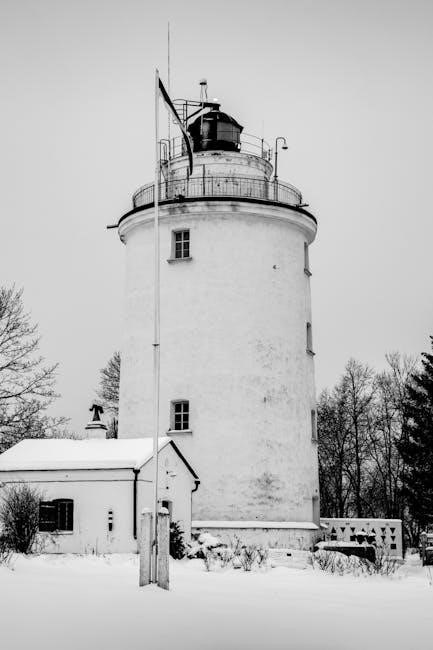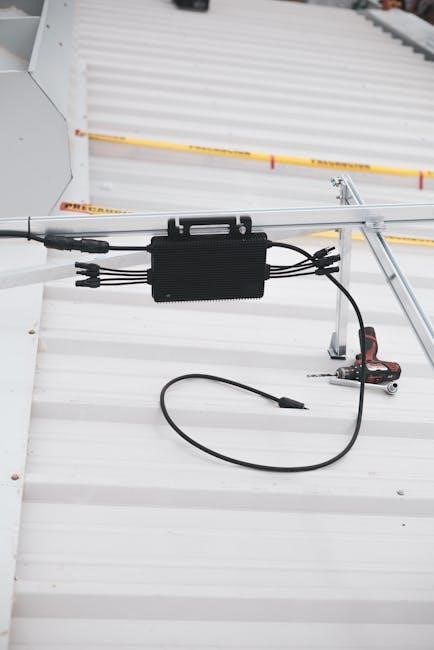Australian Standards AS/NZS 2918 and AS/NZS 4013 regulate wood heater installation‚ ensuring safety‚ efficiency‚ and environmental compliance. These standards guide proper installation‚ emission limits‚ and manufacturer compliance.
Purpose and Overview
The purpose of Australian Standards for wood heater installation is to ensure safety‚ efficiency‚ and environmental protection. These standards‚ such as AS/NZS 2918 and AS/NZS 4013‚ provide detailed guidelines for installing solid fuel burning appliances. They outline requirements for flue systems‚ clearances‚ and emissions to minimize risks and environmental impact. The standards also aim to promote energy efficiency by setting minimum performance criteria. Compliance with these standards ensures that wood heaters operate safely and effectively‚ reducing hazards like carbon monoxide emissions and fire risks; Additionally‚ they provide a framework for manufacturers and installers to follow‚ ensuring consistency and reliability in wood heater installations across Australia. By adhering to these standards‚ homeowners can enjoy the benefits of wood heating while protecting their health‚ property‚ and the environment. Proper installation is critical to meeting these objectives‚ making professional expertise essential.
Key Regulations and Standards
The primary regulations governing wood heater installations in Australia are outlined in AS/NZS 2918:2018 and AS/NZS 4013:2014. AS/NZS 2918 focuses on the installation of domestic solid fuel burning appliances‚ covering aspects such as flue height‚ material requirements‚ and clearances. AS/NZS 4013 sets emission limits‚ ensuring wood heaters meet environmental standards by restricting particulate emissions to 1.5 g/kg or less. These standards ensure installations are safe‚ efficient‚ and environmentally compliant. Compliance with these regulations is mandatory for both manufacturers and installers. Additionally‚ heaters must display a compliance plate‚ verifying adherence to these standards. These regulations collectively aim to balance safety‚ efficiency‚ and environmental protection‚ ensuring wood heaters are a viable and responsible heating option for Australian households. Adherence to these standards is critical to avoid non-compliance risks and ensure optimal performance.
Compliance Requirements for Wood Heaters
Wood heaters must comply with AS/NZS 2918:2018 and AS/NZS 4013:2014‚ ensuring emissions and efficiency meet standards. Professional installation and compliance plates are mandatory to avoid risks.
Emission Limits and Efficiency Standards
Australian Standards AS/NZS 4012:2014 and AS/NZS 4013:2014 set clear emission and efficiency requirements for wood heaters. Emission limits are capped at 1.5 grams of pollutants per kilogram of fuel burned‚ ensuring cleaner air quality and reduced environmental impact. Efficiency standards mandate a minimum heating efficiency of 60%‚ promoting energy savings and optimal performance. Compliance with these standards is mandatory for all wood heaters sold in Australia‚ verified through rigorous testing and certification processes. These regulations aim to minimize air pollution while ensuring reliable and sustainable heating solutions for households. By adhering to these standards‚ manufacturers and consumers contribute to a healthier environment and reduced carbon footprint.
Certifications and Approvals
Wood heaters in Australia must meet specific certification requirements to ensure compliance with safety and environmental standards. Appliances must carry a compliance plate‚ verifying adherence to Australian Standards such as AS/NZS 2918 and AS/NZS 4013. These certifications confirm that the heater has passed rigorous testing for emissions‚ efficiency‚ and safety. Certification involves third-party testing by accredited laboratories to validate performance claims. Additionally‚ installers must ensure compliance with local regulations and manufacturer instructions. Certifications are crucial for legal installation and operation‚ as non-compliant heaters cannot be sold or installed. Authorities may inspect installations to verify compliance‚ ensuring public safety and environmental protection. Proper certification guarantees that wood heaters operate safely and efficiently‚ aligning with national standards and reducing risks of non-compliance.

Installation Requirements
Installation of wood heaters must adhere to specific requirements‚ including flue height‚ clearance distances‚ and floor protection measures‚ ensuring compliance with Australian Standards for safe operation.

General Guidelines
Wood heater installations must follow Australian Standard AS/NZS 2918:2018‚ ensuring compliance with design‚ material‚ and placement requirements. Heaters should be positioned to minimize fire risks‚ with clearances maintained from combustible materials. The installation process must align with manufacturer instructions‚ and all components‚ including flues‚ must meet specified standards. Proper ventilation and structural integrity are essential to ensure safe and efficient operation. Regular inspections and maintenance are recommended to uphold safety and performance standards. Adherence to these guidelines ensures compliance with both regulatory requirements and manufacturer recommendations‚ promoting a safe and efficient heating solution.
Flue Height and Material Requirements
The Australian Standard AS/NZS 2918:2018 specifies that flues for wood heaters must be at least 4.6 metres above the floor where the heater is installed. Flues must be constructed from materials that can withstand high temperatures‚ such as stainless steel or clay‚ ensuring durability and safety; The flue system must also include a spark arrester to prevent ember escape and a flue cap to protect against weather and debris. Proper flue installation is critical to ensure efficient ventilation‚ reduce fire risks‚ and comply with safety regulations. All components must meet the standards outlined in AS/NZS 2918 to guarantee safe and efficient operation of the wood heater. Regular inspections are recommended to maintain the integrity of the flue system.
Safety Measures

Safety measures for wood heater installation include mandatory floor and wall protections to prevent heat damage. Secure installations ensure compliance with Australian Standards‚ preventing accidents and ensuring safe operation. Proper protections also prevent shifting during seismic events‚ maintaining heater stability and safety.
Clearance Requirements
Clearance requirements for wood heater installations are critical for safety and compliance. The Australian Standard AS/NZS 2918:2018 specifies minimum distances from combustible materials‚ such as walls‚ floors‚ and ceilings. These clearances vary based on the type and output of the heater‚ as well as the materials surrounding it. Proper clearance ensures that heat does not ignite nearby flammable substances. Installers must also consider factors like ventilation and insulation when determining safe distances. Adhering to these requirements is essential to prevent fires and ensure the heater operates safely and efficiently. Compliance with these standards is mandatory‚ and deviations can lead to serious safety risks. Always consult the manufacturer’s instructions and local regulations for specific clearance guidelines. Professional installation guarantees adherence to these critical safety measures.
Floor and Wall Protection
Floor and wall protection are essential for safe wood heater installation. The Australian Standard AS/NZS 2918:2018 requires heat-resistant materials‚ such as stone or brick‚ to be placed under and around heaters. Floors must have a protector extending at least 300 mm beyond the heater on all sides. Walls near the heater must be shielded with insulation or heat-resistant panels to prevent damage from radiant heat. These measures ensure that combustible materials do not ignite due to prolonged exposure to heat. Non-compliance can lead to fire hazards and safety risks. Proper protection also extends the lifespan of surrounding structures. Always follow manufacturer guidelines and local regulations for specific requirements. Professional installers ensure these protections are correctly implemented.

Importance of Professional Installation
Professional installation ensures compliance with AS/NZS 2918:2018 standards‚ guaranteeing safety‚ efficiency‚ and legal requirements. Licensed installers handle complex setups and mitigate risks associated with improper installation.
Role of Licensed Installers
Licensed installers play a crucial role in ensuring wood heater installations meet Australian Standards. They adhere to AS/NZS 2918:2018‚ ensuring flue heights‚ clearances‚ and materials comply with regulations. Installers conduct site assessments‚ verifying floor and wall protection‚ and ensure appliances are correctly fitted. They handle complex tasks like flue installation and ensure proper ventilation to prevent hazardous emissions. Licensed professionals also verify that heaters meet emission limits and efficiency standards‚ such as AS/NZS 4013:2014. Their expertise minimizes risks of non-compliance‚ ensuring safety and performance. Proper documentation and compliance plates are provided‚ confirming adherence to all relevant standards. Regular updates on standard changes ensure installations remain up-to-date and safe.
Risks of Non-Compliance
Non-compliance with Australian Standards for wood heater installation poses significant risks. Heaters that fail to meet AS/NZS 2918 and AS/NZS 4013 standards may emit excessive pollutants‚ harming air quality and public health. Non-compliant installations can lead to legal penalties‚ fines‚ and potential litigation. Insurance claims may be denied if a fire or damage occurs due to improper installation. Additionally‚ non-compliant heaters may not function efficiently‚ increasing fuel consumption and operating costs. Safety hazards‚ such as carbon monoxide leaks or structural fires‚ can endanger occupants. Local councils may issue notices or require costly corrections. Therefore‚ adhering to standards is essential to avoid legal‚ financial‚ and safety risks associated with non-compliance.























